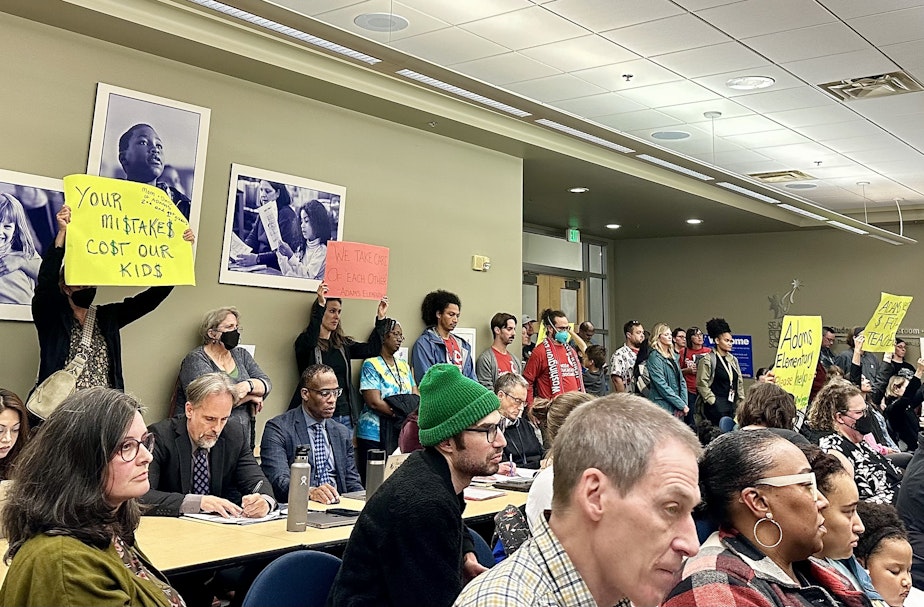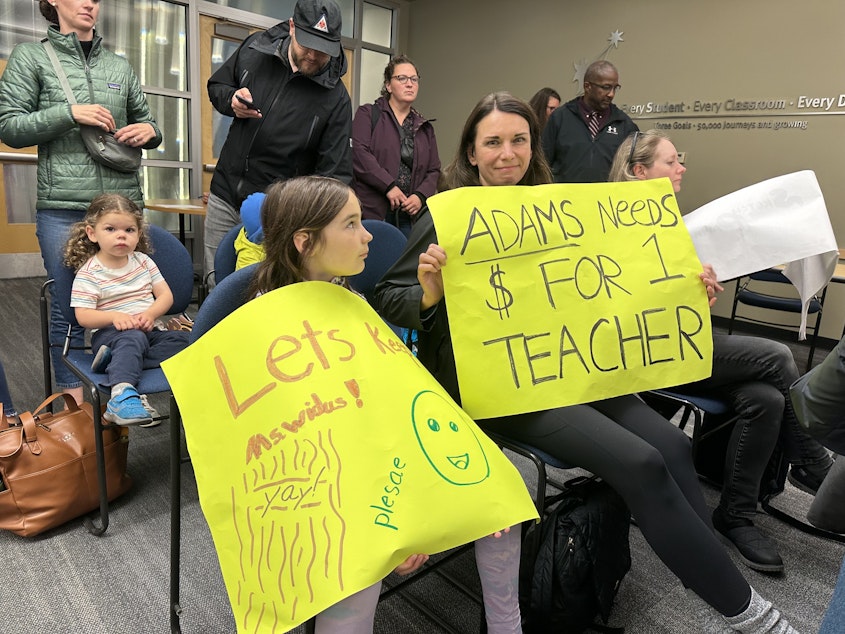'Please don't break our hearts.' Seattle parents, teachers protest widespread classroom shuffles

Seattle parents and teachers flooded a school board meeting Wednesday night to protest recent class size adjustments at about half of the district’s schools.
The move, announced to families and educators last week, means some students and teachers will be moved to new classrooms, while other students may end up in a larger “split classroom” that combines two grades.
Among the students affected is Naomi Strand’s son, Kitten, a kindergartner at Orca K-8 who already loves his teacher and school, and was just getting used to his new routine.
Strand worries about what will happen when Kitten is moved to a split classroom of kindergartners and first graders.
“I’m deeply concerned that this proposed disruption is going to negatively impact my child and many others,” Strand told the board, before letting her son speak.
Sponsored
“I’m in Teacher Tyler’s class,” Kitten said, “and I love it.”
“Please don’t break our hearts," Strand said.
Seattle Public Schools officials say the shuffling is a result of staffing imbalances at some schools that need to be corrected in order to meet state requirements that encourage smaller class sizes at the lowest grade levels.
If the district were to remain out of compliance with the state’s recommended staffing ratios of one educator for every 17 students in K-3 classrooms, it would lose out on $3.6 million in state funding.
While staffing reconfigurations are typical every October, district officials acknowledge that it’s affecting more students and educators this year.
Sponsored
Art Jarvis, the district’s deputy superintendent of academics, estimated about 30 schools deal with class size and staffing adjustments in a typical year. This year, it’s affecting about 40 of the district’s 106 schools.
While the district uses enrollment projections to staff schools every year, Jarvis said it’s impossible to know exact numbers until the school year is underway.
“You want to anticipate what’s coming in … but you don’t want to over-staff,” he said. “We just don’t have that luxury.”
In previous years, Jarvis said the district has been able to provide extra money to schools to minimize classroom staffing changes at this point in the school year.
But that’s not possible this year. The district must take a “stricter approach,” Jarvis said, as it faces continued budget challenges fueled by declining enrollment over the last few years.
Sponsored
RELATED: Here’s when Seattle Public Schools will announce possible school closures
After closing a $131 million deficit last year, the district faces another projected $104 million budget shortfall next school year. Already, teachers, staff, and families are bracing for another year of painful budget cuts and likely school closures.
Jarvis said the district must ensure they’re “not careless” by employing extra staff members and “not making adjustments just because it’s messy.”
He added the cost of inaction is even larger if one considers the cost of employing extra teachers. Labor costs are typically the district’s largest expenditure every year.
Before at least 20 parents and educators spoke during public comment Wednesday, Superintendent Brent Jones apologized for the inconveniences caused by the staff reconfigurations and said district leaders are working hard to minimize disruptions and make adjustments as early in the school year as possible.
Sponsored
“We are collectively challenged in making sure we’re following mandates and rules so that we can get the resources that we need in order to keep our schools solvent,” Jones said. “We recognize that changes during the school year can cause anxiety and frustration for our families.”

But those words appeared to fall flat for the parents and educators who packed the school board meeting. Many criticized the district’s communication of the changes.
“I was listening to the board members speaking at the beginning of the meeting, talking about striving to make the schools a place where children feel safe and feel attended to,” said Beth Steinhaus, the parent of a second grader at Orca K-8. “Breaking up classrooms, causing the entire school to switch course a month and a half into the year does the exact opposite.”
Jennifer Matter, president of the Seattle Education Association, also criticized the district’s timing, saying officials could have solved the issue before the school year.
Sponsored
Matter claimed the projections they were using for staffing last spring were inconsistent with the state’s K-3 staff ratio requirements.
And now, Matter said, the district's about 50,000 students and over 6,000 teachers, who are still recovering from Covid, will suffer.
“The added disruption of preventable staffing changes has further impacted everyone's morale, and will impact student outcomes such as our third grade reading scores at our priority schools,” she said. “Our students and families deserve and need stability and consistency."
Parents and educators also questioned whether the shifts would actually make K-3 class sizes smaller. At several schools, class reconfigurations appear to be affecting the younger students who the district says are supposed to be benefitting from smaller class sizes.
Cortny Helmick, the parent of an Adams Elementary third grader and the school’s PTA president, said two second and third grade classes are being combined into a split.
“These affected third graders are the same kids who attended online kindergarten. We’ve seen them struggle academically and emotionally,” Helmick told the board. “The second grade class is still recovering from the effects of socially-distanced kindergarten and isolation. These kids deserve more consistency and consideration, as do the five affected teachers.”
The district said the classroom changes are expected to be completed by the end of the month.




